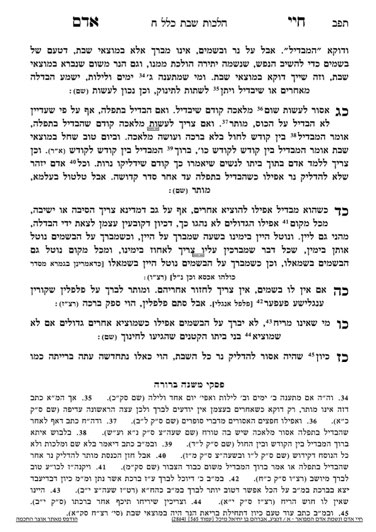BE”H, we will be starting Klal 9 on January 1st. Klal 9 is all of the basic rules of meleches Shabbos, and therefore a very important klal. Sponsorships are available for the whole klal or individual concepts or individual shiurim. Please contact Rabbi Reingold at (301)996-5910 or rabbireingold@gmail.com to sponsor
We are continuing in siman 27, discussing the halachos of the neir used for havdalah. There is a discussion whether the bracha on the neir is a birchas hanehenin or birchas hashevach. If it is considered a birchas hanehenin, the bracha is being made on the benefit accrued from the object, and therefore one is not allowed to benefit from the neir until making the bracha. If it is a birchas hashevach, the bracha is being made as a praise to Hashem for creating the item, so the bracha is made after enjoying the item.
According to the Mishnah Berurah, the bracha of neir is a birchas hashevach, meaning, it is primarily thanking Hashem for the concept of fire, and therefore one should benefit from it before making the bracha. As another example, when it comes to the brachos made on natural wonders, such as the sea or a mountain, a person first takes in the sight before making the bracha, because a person first appreciates the sight before making the bracha of praise.
However, Rav Moshe points out that both the Gra and Rav Yaakov Emden hold that a person should make the bracha before benefitting from the neir, even though they agree that it is a birchas hashevach, but it functions like it is a birchas hanehenin. Therefore, he writes that even though most achronim understand the bracha is a birchas hashevach, he concludes that one should still treat it similar to a birchas hanehenin. Therefore, one should first make the bracha and then derive benefit from the neir. Those who first look at the neir are relying on the Mishnah Berurah, but Rav Moshe writes strongly that one should make the bracha before looking at the neir.
In siman 28, the Chayei Adam writes that the mitzvah is to make a bracha on a candle which has two or more wicks, called an avukah. The bracha is meorei haeish, which implies multiple colors of fire. Meorei also implies multiple sources of fire. If the two wicks are not twisted together, they should be touching, because otherwise it is not considered an avukah. However, it is important to note that this concept of avukah is an extra mitzvah, but not meakeiv. Therefore, when Yom Tov is Motzei Shabbos, although it is muttar to light a neir from another neir, it is only muttar to extinguish a neir for the purpose of ochel nefesh, food preparation. Thus, although it would be muttar to create a larger fire by putting two wicks together, one is diminishing the flame by pulling them apart afterwards. Although some poskim hold that separating the wicks is different than extinguishing them, others consider it extinguishing. Therefore, because avukah is not meakeiv, one should not put two wicks together, but should rather make the bracha on one wick.
It is possible to obtain special yakneha”z candles, which have two wicks but do not last long enough to create safety issues. It is important to note that these candles are a hiddur but not a chiyuv.
Summary
- One should make the bracha of borei meorei haseish before looking at the neir.
- It is preferable to use a candle that has two wicks, but is not meakeiv.



